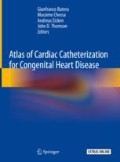Abstract
3D rotational angiography (3DRA) is an evolving technique that delivers computer tomographic imaging at the heart catheterization suite. A 180 º rotation of the frontal plane during an interval of 4–7 s produces a rotational angiography (RA) when contrast is injected simultaneously with vendor-specific differences in the post processing.
Access this chapter
Tax calculation will be finalised at checkout
Purchases are for personal use only
Author information
Authors and Affiliations
Corresponding author
Editor information
Editors and Affiliations
1 Electronic Supplementary Material
Case 1. 3D rotational angiography in post-surgical re-coarctation (MOV 1544 kb)
Case 2. 3D rotational angiography post-balloon dilatation in Re-CoA demonstrates dissection. A Cook Formula 10 × 20 has been implanted (MOV 4470 kb)
Case 3. 3D rotational angiography in complex pulmonary artery bifurcation stenosis and PPVI. Both PA branches and Melody valve are visualized in different cross-sectional planes. Two stents across the bifurcation are implanted by using Y stenting with telescope and anchor techniques. Ev3 Mega LD and ev3 Max LD have been implanted. Finally, 3DRA shows pre- and post-intervention stent positions and dimensions (MOV 37640 kb)
Case 4. Sano shunt anatomy and stenosis at the origin of the left pulmonary artery (MOV 3416 kb)
Case 4. 3D rotational angiography road map for stent implantation in Sano shunt stenosis. Note the anatomic shift 2D versus 3D, correction of shift performed manually (MOV 10521 kb)
Case 5. Left pulmonary artery stenosis in total cavopulmonary connection. It is possible to visualize DKS, left pulmonary artery (LPA), and airways. Furthermore, LPA ballooning is performed in order to check for bronchus compression (MOV 2600 kb)
Case 6. Percutaneous pulmonary valve implantation (PPVI). Entire heart protocol and interrogation protocol (MOV 36490 kb)
Case 7. Complex PPVI. Entire heart protocol and interrogation protocol (MOV 13243 kb)
Case 8. A 3-year-old child with PA VSD after Melbourne shunt, unifocalization, multiple stent interventions, and implantation of Contegra valve during correction. Severe distal MPA and bifurcation stenosis post surgery are seen by using 3d rotational angiography (MOV 10623 kb)
Rights and permissions
Copyright information
© 2019 Springer International Publishing AG, part of Springer Nature
About this chapter
Cite this chapter
Krings, G. (2019). 3D Rotational Angiography for Percutaneous Interventions in Congenital Heart Disease. In: Butera, G., Chessa, M., Eicken, A., Thomson, J.D. (eds) Atlas of Cardiac Catheterization for Congenital Heart Disease. Springer, Cham. https://doi.org/10.1007/978-3-319-72443-0_38
Download citation
DOI: https://doi.org/10.1007/978-3-319-72443-0_38
Published:
Publisher Name: Springer, Cham
Print ISBN: 978-3-319-72442-3
Online ISBN: 978-3-319-72443-0
eBook Packages: MedicineMedicine (R0)

